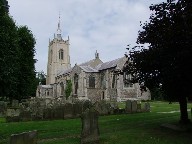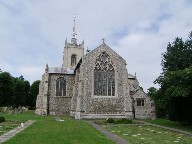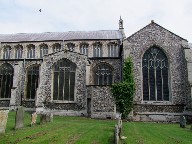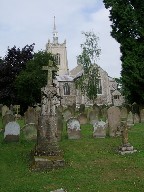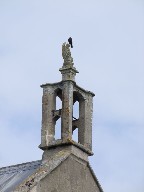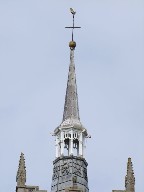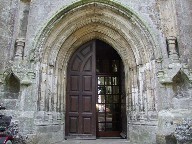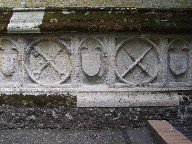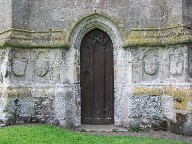| |
|
St Peter
and St Paul, Swaffham
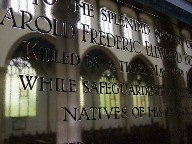 |
|
Swaffham
is the most elegant of Norfolk's smaller towns,
and, architecturally at least, its parish church
is one of the great East Anglian small town
churches, to be mentioned in the same breath as
the likes of Dereham and Mildenhall. It sits
close to the western edge of its churchyard, a
passageway leading through from the west doorway
to the market place, a pleasingly organic
juxtaposition. The glory of St Peter and
St Paul is the tower, which went up early in the
16th Century on the eve of the Reformation.
Another twenty years or so and it would not have
happened. Like that at Cawston, it is built of
rugged Barnack stone, and is elaborately
decorated with symbols, most notably the large
wheels containing the crossed keys of St Peter
and the crossed swords of St Paul, which appear
around the base course. There are blank shields
between them, and the whole base course was once
perhaps painted.
|
The lead
and wood fleche on top of the tower is 19th Century, but
it replaced a similar earlier structure. There are aisles
and clerestories to north and south, as well as a large
transept chapel on the south side. The churchyard
stretches away to the east, with no shortage of good 18th
and 19th Century headstones, a suggestion of quite how
wealthy this town has been over the last few hundred
years. You enter the church through the great west
doorway, one of the grandest entrances to any Norfolk
church, and the sheer bulk of the building spreads out
before you. This is a church which seems larger inside
than out. The space is topped off by a fine late medieval
angel roof, which is said to be chestnut (although I have
heard of several medieval chestnut roofs in East Anglia
which, on proper investigation, turned out to be oak
after all).
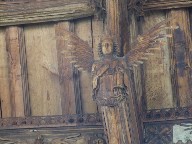 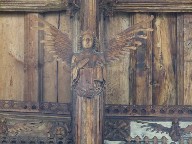 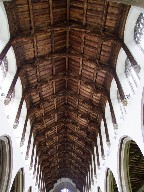 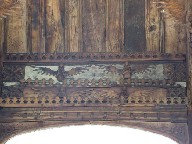 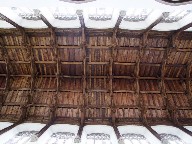
Perhaps
inevitably, St Peter and St Paul underwent as extensive a
restoration in the 19th Century as any small town church,
giving it an urban and somewhat anonymous character
inside. Nevertheless, there are some good early
survivals, the best of which are perhaps the figures on
stalls in the chancel which peer out, rosaries in hand,
presumably 15th Century donors.Opposite them is a large
19th Century bench end of man and his dog, the Pedlar of
Swaffham, of which more in a moment.
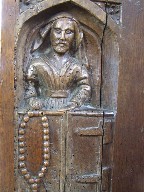 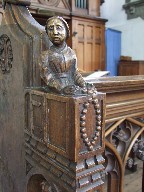 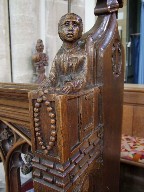 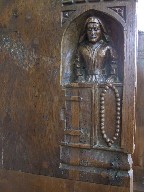
The story
of the Pedlar of Swaffham is interesting, because it
relates to this church as we see it today. In the legend,
John Chapman, the pedlar in question, learns of the
whereabouts of a large sum of money in a dream, finds it
and gives it to provide the church with a north aisle and
the magnificent tower. Interestingly, the upper lights of
the north aisle are now filled with figures in 15th
Century glass, some of which are angels, but some of
which are clearly donors. There are more medieval panels
in the west window.
The
best-known glass in the church, however, is modern. It is
in the south transept, the former chapel of the guild of
Corpus Christi. This is now the WWI memorial chapel, and
its main feature is a large window by William Morris of
Westminster. The four main figures are St George, St
Martin, St Michael and the Blessed Virgin, but perhaps
more interesting are the smaller panels at the bottom,
which depict the fighting at Zeebrugge, Jerusalem and
Mons, and a scene inside a field hospital. The archangel
Michael is shown above the scene of Mons, on the Western
Front, where it was widely believed at the time that a
host of angels had led the British troops into battle.
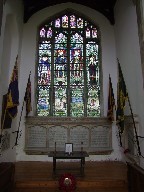 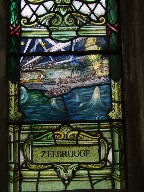 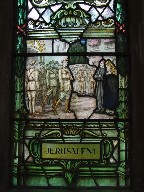 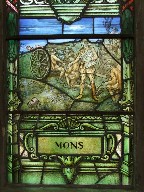 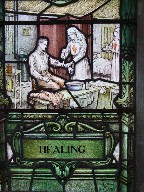
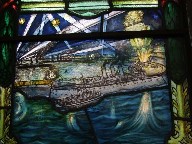 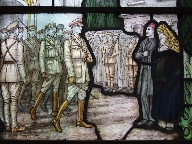 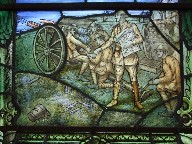 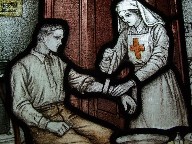
John
Botright, the 15th Century rector of the church who
oversaw the late medieval rebuilding of the nave and
chancel, lies in effigy on the northern side of the
sanctuary. Unfortunately, he suffered the ignomy of
having his tomb canopy lowered by the 19th Century
restorers. The jagged cusping of the arch comes down to
just above his body, to the extent that it looks as if he
is being eaten by his own tomb. In the south aisle chapel
lies Katherine Steward. She died in 1590, and now kneels
piously regarding the modern sanctuary furnishings,
holding a huge and hideous skull in her hands. What gives
her added significance is that she was Oliver Cromwell's
grandmother. More alarming even than Katherine Steward's
skull is an inscription on a modern brass nearby to
the Splendid Memory of Harold Frederick Ellwood Bell ICS,
who was killed by a tiger in 1916 while
safeguarding some of the natives of his district. I
assume that he suffered this fate in some far-flung
corner of the British Empire rather than unexpectedly in
a local field - although, of course, strange things do
happen in Norfolk.
|
|
|

